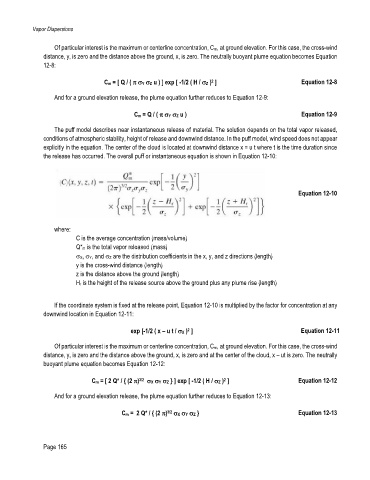Page 205 - CHEF Guide
P. 205
Vapor Dispersions
Of particular interest is the maximum or centerline concentration, Cm, at ground elevation. For this case, the cross-wind
distance, y, is zero and the distance above the ground, x, is zero. The neutrally buoyant plume equation becomes Equation
12-8:
Cm = [ Q / ( Y Z u ) ] exp [ -1/2 ( H / Z ) ] Equation 12-8
2
And for a ground elevation release, the plume equation further reduces to Equation 12-9:
Cm = Q / ( Y Z u ) Equation 12-9
The puff model describes near instantaneous release of material. The solution depends on the total vapor released,
conditions of atmospheric stability, height of release and downwind distance. In the puff model, wind speed does not appear
explicitly in the equation. The center of the cloud is located at downwind distance x = u t where t is the time duration since
the release has occurred. The overall puff or instantaneous equation is shown in Equation 12-10:
Equation 12-10
where:
C is the average concentration (mass/volume)
Q*m is the total vapor released (mass)
X, Y, and Z are the distribution coefficients in the x, y, and z directions (length)
y is the cross-wind distance (length)
z is the distance above the ground (length)
Hr is the height of the release source above the ground plus any plume rise (length)
If the coordinate system is fixed at the release point, Equation 12-10 is multiplied by the factor for concentration at any
downwind location in Equation 12-11:
exp [-1/2 ( x – u t / X ) ] Equation 12-11
2
Of particular interest is the maximum or centerline concentration, Cm, at ground elevation. For this case, the cross-wind
distance, y, is zero and the distance above the ground, x, is zero and at the center of the cloud, x – ut is zero. The neutrally
buoyant plume equation becomes Equation 12-12:
3/2
Cm = [ 2 Q* / { (2 ) X Y Z } ] exp [ -1/2 ( H / Z ) ] Equation 12-12
2
And for a ground elevation release, the plume equation further reduces to Equation 12-13:
Cm = 2 Q* / { (2 ) X Y Z } Equation 12-13
3/2
Page 165

